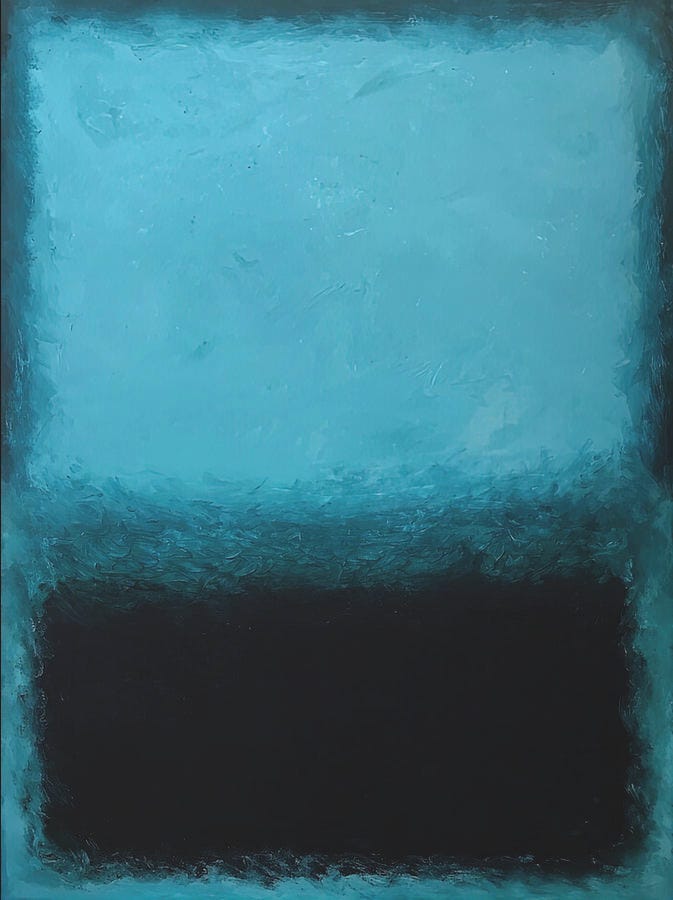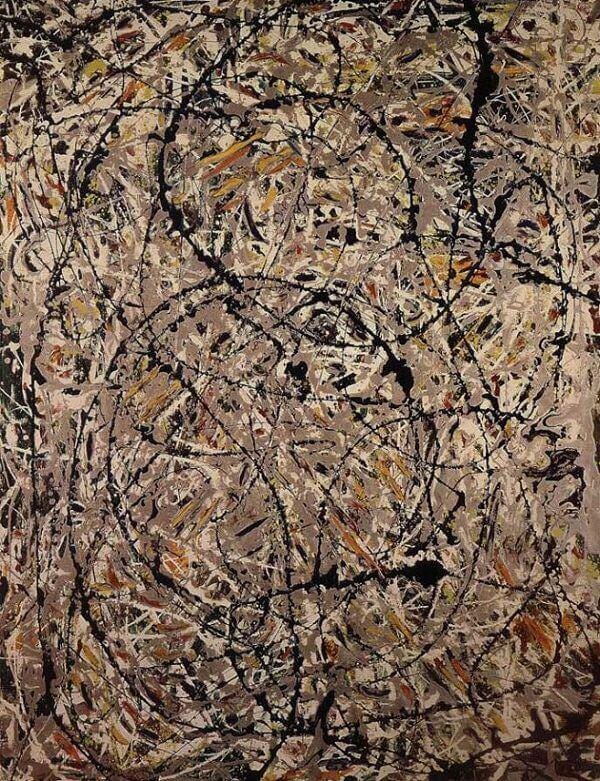Undulating Psychosis
Jackson Pollock and the End of Rectitude
I bought another Jackson Pollock print. I don’t love Pollock’s work; in fact, I dislike most of it but the pieces I do like captivate me for reasons I find elusive. I’m drawn in. There’s no emotion I feel or affected description of pigments or ancestral resonance I can muster to describe why I like them. They make me wonder why I can’t see the hidden meaning.
Would Pollock like to know this about me? Maybe. He’d probably care long enough to shrug.
It seems criticism of his art irritated Pollock to a greater degree than praise for it gave him joy. One writer referred to him as Jack the Dripper. That stung, clever as it might be. That a critic in an ill-fitting suit that smelled of Chesterfields and Aqua Velva would so viciously miss the point of his work only gave Pollock another entry on a sturdy list of reasons to abuse alcohol.
Rumor has it he once walked into a Long Island house party nude and peed in the fireplace. Maybe he always wanted to be a firefighter. Everyone loves firefighters.
He died the way drunks often do. The last thing that went through his mind was the steering wheel of his Olds 88. The 1956 crash that ended Pollock’s life at 44 also seriously injured his lover, Ruth Kligman, and killed another passenger, Edith Metzger, just 26 years old.
If it isn’t apparent yet, I know nothing about art. I don’t even know enough to pretend I know more, a trick one can deploy on the contemptibly ignorant. But I do know that Jackson Pollock had an impact on the art world. Whether you believe him to be a genius or a pawn in a marketing strategy orchestrated by the CIA (yeah, look it up), he changed the way people contemplate, discover, or argue about what is worthy of awe and what should line a parrot cage.
It doesn’t matter because he mattered. His work mattered. You can’t ignore history because you think his work and that of other abstract expressionists like Mark Rothko are crap. You need to consider context. The CIA funded art exhibitions that accelerated the careers of these and other men to heckle the state-mandated realist artwork produced in the Soviet Union. It was all Stalin permitted in the make-believe glory of communism. The significant expansion of interest in art, and the moving of the epicenter of contemporary exhibitions from Europe to New York was a way of showing the Bolsheviks that the United States was freedom unbound, that American artists could express themselves as they dared, without the constraints imposed by the wardens of gulag.
Rothko’s first government boost came a decade earlier from a federal initiative called the Work Progress Administration, engineered during FDR’s reign to keep unemployed Americans working. The WPA funded a variety of work programs, including a few in the arts. For most Americans at the time, it helped them keep their dignity by earning their share of open coffers.
Sidebar: in February of 1970, Mark Rothko killed himself in his kitchen by slamming barbiturates, then taking a razor to an artery in his arm. He was 66. Despite great financial success, he died with over 800 unsold paintings and a host of physical and mental ailments, some exacerbated by booze or nicotine or whatever else armed him for war with his demons.
People are sometimes moved to tears in the presence of Rothko’s paintings. The cynic in me thinks at least some of those reactions have been performative. Those who don’t like his work see it as blocks of color a child could render, but others see the deeply felt emotions that Rothko strove to express. His art didn’t represent anything. The paintings weren’t metaphors. There wasn’t any ironic symbolism. To his mind, and to a great extent, Pollock’s, the art was the thing itself, nothing more. The thing wrought from within, the process as an open door to the soul. The canvas, a resting place for a moment in time in the lives of tormented men who lived in the prodromal phase of suicidal maneuvers.
I think Rothko was synesthetic. Whether it’s a gift or an affliction depends on the individual. But color, its depth and translucence–captured in his work in part because of the way Rothko prepped his canvases and manipulated the viscosity of his paint–triggered real emotional responses in him. Perhaps those who have had intense reactions to his work are also on the synesthesia spectrum.
Pollock went from near obscurity to the wunderkind of the art world, blowing over Europe like the Sciroccos. His fame grew during a period in US history when Americans felt pretty good about themselves. The baby boomers were toddlers. WWII had started to become a memory. Middle-class Americans could furnish their homes with inexpensive items manufactured from plywood, laminates and plastic. They were making babies as though the post-war swing would last for generations to come. Americans had pulled off a great victory and felt invincible.
Collective pride had an analgesic effect on the national post-war psyche, but not on the pain felt by individual families. There were more than 18,000 American casualties in the North African theater, while more than 180,000 were killed in Europe, and an untold number of wounded and psychologically strafed, all because we believed war against the Nazis was a just and noble sacrifice. Indeed, it was. But in recent decades, our lust for military power, regime change and dollar dominance, along with our unholy alliance with Israel, has defiled their graves and mocked the precepts of a Madisonian nation.
That Israel is committing war crimes and genocide in Gaza is inarguable at this point, regardless of who wants to blame whom for starting it. The US provides intel, cash, tech support and killing instruments to the IDF to facilitate their plans to disappear the Palestinians. Under international law, liability for genocide extends to those who “planned, instigated, ordered, committed or otherwise aided and abetted in the planning, preparation or execution” of one or more genocidal acts. These acts are live-streamed and cheered by its executioners with total impunity, as the world watches in horror in the realization that “never again” doesn’t include Arab women and their children.
You can debate blame for the start of the war, but the liquidation started long before October seventh. In a fact only related by this post, while Jackson Pollock was being lauded in the culture pages, the Nakba was underway in Palestine. Nakba translates to catastrophe, a term that has become brutally prophetic. Hamas is not a band of angels. It’s deplorable that they killed civilians in the 10/07 attack. Whatever your opinion on whether they should exist, Hamas is a product of imprisonment, the latest iteration of an armed resistance to occupation, something the Palestinians have a right to under international law. Hamas, by the way, was formed forty years after the start of the Nakba.
The Zionists and their supporters have claimed the destruction of Gaza and the slaughter of innocents is the fault of Hamas alone, but that presumes two things. One is that the conflict began on 10/07, but you can’t ignore the history that undermines your narrative, although the Israeli government and our corporate media try their best to do just that. The second, as I’ve written before, is the issue of proximate cause, not of hostility but of the execution of this current onslaught. When the family of a wounded man runs to his aid and a quad-copter drops in and fires shrapnel at his kids, or when a suicide drone detonates in a refugee tent camp, or when the Where’s Daddy AI targets a “Hamas affiliate” after he arrives home to his family, it’s IDF soldiers at the controls of those weapons. Those soldiers have committed war crimes by every common, internationally accepted definition, then posted them on Tik Tok. “Human agency is still central to Israel’s AI-powered warfare.” – Sophia Goodfriend, 972 Magazine.
We Have Failed
We have failed those who sacrificed in the second World War, those who beat back a malevolent Reich, and now, eighty years later, deep in the armchairs of our privilege, we allow the neocon warmongers to rally us through our media to cheer the annihilation of a people we know nothing about but have been inculcated to associate with terrorism.
You don’t have to be black-pilled by Whitney Webb to see the treachery of our intel apparatus and it’s sinister, inviolable links to the Mossad, the Military Industrial Complex and the corrupt power brokers who engorge themselves on the profits of conflict and chaos.
We have failed our fathers. We have failed to be the fathers we once hoped we could be, that perhaps, for a time, deserved to be, and we are failing our children. We have failed our national dignity and our international reputation. The world has seen us for what we are. We are no longer the saviors of the downtrodden. We are the evil that men do by back-channel approvals, apathy, or unapologetic complicity. We have failed because we’ve chosen to. We are placated by bread and circuses, the kilometers that separate us from the fetid rubble, and the lies we allow ourselves to believe as we scroll past incontrovertible evidence of atrocities. The lies we tell ourselves become the truths we tell our children.
The infectious psychosis that has stricken the ruling zealots of Israel, together with the hateful eight of our deep-state: the Pentagon, elitist think tanks, political parties, defense contractors, CIA, NSA, corporate media and the unctuous purveyors of neo-conservatism, will destroy what’s left of the United States. There is a cultish bloodlust in DC and Tel Aviv, and it’s spreading beyond the Negev. The Manson family of the Middle East will not stop at extermination in Gaza, or Syria, or Lebanon or even Iran. They are an army with a flaming sword, a weapon fueled by the blob, the criminally enriched who hide behind the language of an America that once was, supporting a nation that quotes a vengeful and violent scripture to justify the extermination of the new Amalekites.
You can look back and believe Pollock, Rothko and their ilk were not good artists, you can’t ignore the fact that they profoundly changed art. You can look at US history through the lens of the CIA, through USAID, and say that America was never admirable. But hey, for a little while, it felt good to believe we were. It felt good to believe that collectively we were capable of exceptionalism because the founders wrote a framework upon which exceptional ideas could take hold. Sadly, we have re-defined greatness as hegemony, with all the indifference of a sociopathic empire. Our leaders preach justice while standing on the graves of babies.






I wrote on the ab Ex painters here https://john-steppling.com/2014/04/revisiting-the-new-york-school/ These were working class artists (much later wealthy, if they lived) and from non-elite art schools. They supported civil rights and progressive causes, very quietly,. and they were mostly if not entirely from immigrant families.